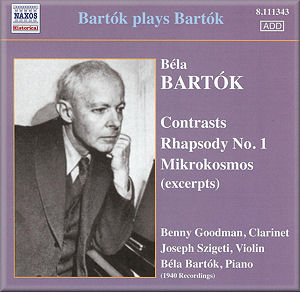 |
 |
|

Not available in the USA
CD: AmazonUK
Download: Classicsonline
|
Bela BARTÓK (1881-1945)
Contrasts for violin, clarinet and piano, Sz111 (1938) [16:57]
Rhapsody No.1 for violin and piano Sz86 (1928) [9:13]
Mikrokosmos Sz107 (excerpts) (1926-39) [45:24]
 Béla Bartók (piano); Joseph Szigeti (violin); Benny Goodman (clarinet)
Béla Bartók (piano); Joseph Szigeti (violin); Benny Goodman (clarinet)
rec. New York, 1940, 13 May (Contrasts), 4 May (Rhapsody),
29-30 April, 7 & 16 May (Mikrokosmos)
 NAXOS HISTORICAL 8.111343 [71:35]
NAXOS HISTORICAL 8.111343 [71:35] 
|
|
|
Why ever would you go for an ancient mono
recording of these pieces, when there are numerous hi-tech
digital CDs around offering squeaky-clean modernity? There
used to be
only one answer to this with these recordings – look at the
list of performers; the composer himself at the piano, the
incomparable
Benny Goodman, who commissioned Contrasts, and virtuoso
violinist fellow Hungarian and friend of Bartók, Joseph Szigeti.
These recordings have been available in the past in numerous guises
via the CBS and Hungaroton labels, but with a re-mastering by
Mark Obert-Thorn we now have a second reason for acquiring them
– again, if necessary.
The three movements of Contrasts was always a highlight
in this 1940s sequence, and the reasons are clear from the
outset. It is that edgy asymmetry of rhythmic emphasis, a characteristic
of Hungarian music in general, which can be heard both through
performers who have this as part of their musical and physical
DNA, and the ever flexible jazz/classical soloist whose sensitivity
sometimes sees his clarinet sound adorning the violin like
a second skin. Goodman’s mellow tones act as a foil to Szigeti’s gritty violin sound, and the chemistry between all of these musicians has a special vibrancy which prevents one standing out over the others. The swing and ‘schwung’ in
the final Sebes of ‘fast dance’ is infectious. This
is initially a relief from the dark moods and low sonorities
in the central movement, Pihenö or ‘Relaxation’, but its central section is as powerful a piece of music as anything in Bartók’s
output. Elderly the recording may be, but the nuances of timbre
have to my ears never sounded better, and I am sure there is
an enhanced feel of air between the players, almost tricking
the ear into experiencing the recording as rudimentary stereo.
The Rhapsody No.1 allows Bartók’s own piano playing
to come through with a little more clarity than through the
textures of Contrasts, though the piano comes off least
well in these recordings in general, being rather diffuse and
distant. The violin in this case is rather more forward, but
thanks to Szigeti’s expressive, often pleadingly emotional tones, this is something one can take without difficulty. In his notes for this release, Colin Anderson notes the feeling of improvisatory freedom in both of these player’s approach to this piece – accurate in the letter of the score, but with a sense of expansive dynamism which can only come from an absolute inhabiting of the music and its idiom, “mutual
trust and complete identification with the music, its ethno
roots and its final sophistication, in playing both free and
focused.”
Bartók’s recordings of extracts from Mikrokosmos make
for fascinating listening. 32 separate pieces in all, only
two of which tip over the two-minute mark, the composer’s own
performances are an object lesson as to how the pieces can
be made into effective concert miniatures rather than static
study exercises at the keyboard. I wish I had known these recordings
when I was attempting the Mikrokosmos as a reluctant
teenager – these recordings really do bring the music to life, and ancient recording is of no account here: like those dim and distant tracks by Jimmy Yancey, there is no substitute for the real thing, even if recorded through an old sock. What shines through here is the wit and colour Bartók
consistently produces as a pianist. Something like track 12,
the Bagpipe, turns what might become a repetitive musette into a kaleidoscope of swelling patterns and sonorities. Hearing those Dances in Bulgarian Rhythm like this is the equivalent of discovering an old cassette tape of Chopin playing his own Preludes.
Just imagine: hearing them more ‘right’ than you’ve ever heard
them before. Rhythmic variety, polytonality, playful dissonance and serious consonance are all to be found amongst these remarkable pieces, to be ignored by pianists and composers alike to their distinct disadvantage.
Without going on at boring length about how significant and
wonderful the content of this CD is, I think you will probably
have gathered that this is a real and genuine must for all
Bartók enthusiasts and students. There are no comparison recordings:
not because all others should be discounted as inferior, but
for the straightforwardly objective reason that the recordings
on this disc are the standard against which all others can
be judged. With this carefully prepared re-mastering of these
uniquely priceless old recordings, we now have our best cake,
and can eat it at bargain price.
Dominy Clements
|
|

